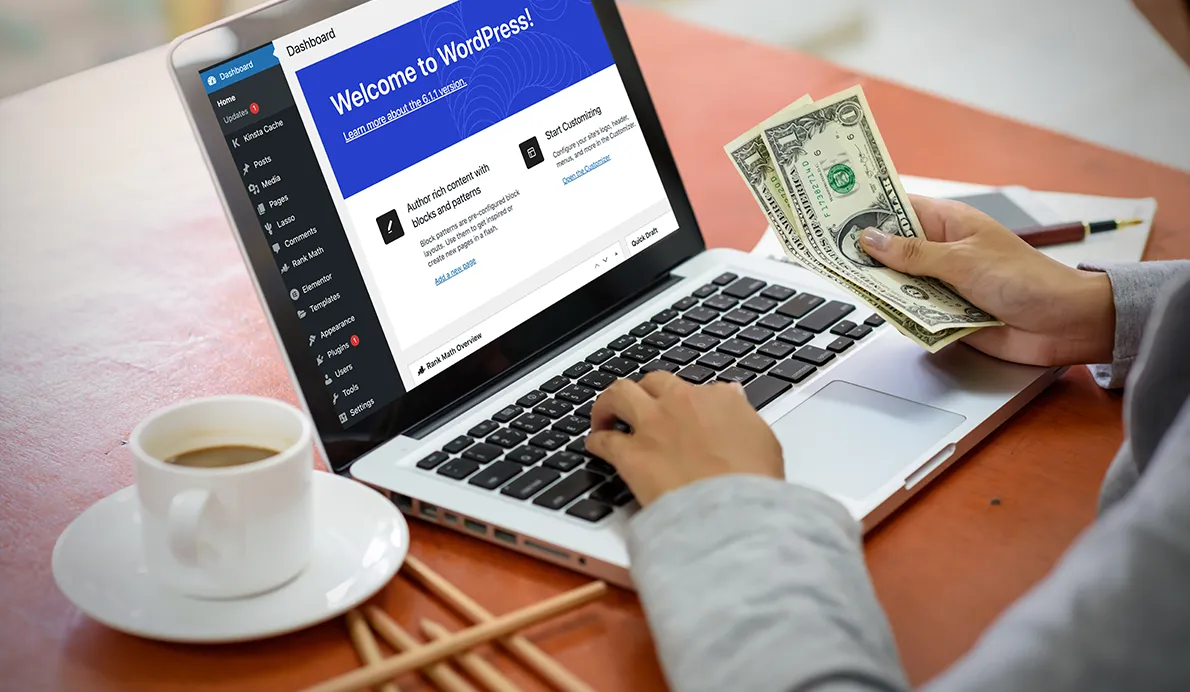Software-as-a-Service (SaaS) application in the digital era has emerged as a boon, revolutionizing the way businesses operate and deliver software solutions. These cloud-based applications are accessible from anywhere, eliminating the need for complex installations and costly infrastructure. You just have to subscribe on a monthly, annually or other timely basis to avail yourself of the software services. But having a SaaS of your own is undoubtedly a huge plus. So, if you are considering venturing into the world of SaaS application development, you are in the right place. This step-by-step guide will walk you through the comprehensive process of creating your own SaaS application, ensuring that you build a successful and user-friendly solution. We will start by understanding SaaS and then we will delve into other components of the development process.
What is SaaS?
Before we dive into the development process, let’s briefly expatiate on what SaaS stands for. Software as a Service (SaaS) is a cloud computing model in which software is hosted and made available to customers over the internet on a subscription basis. Unlike traditional software, SaaS applications can be accessed from any device with an internet connection, making them incredibly convenient for users.
The Importance of SaaS Applications
- SaaS applications have gained immense popularity due to its plethora of pros and are now an integral part of our personal and professional lives. Here are some of the reasons of its importance:
- Accessibility: Users can access SaaS applications from anywhere, anytime, if they have an internet connection. This accessibility fosters productivity and collaboration, especially in today’s remote work environment.
- Cost-Efficiency: SaaS eliminates the need for users to invest in hardware, software licenses, and maintenance. Instead, they subscribe to the service, paying only for what they use.
- Scalability: SaaS applications are highly scalable. Users can easily add or reduce the number of licenses, and the provider handles the infrastructure, ensuring that the software can accommodate growth.
- Automatic Updates: SaaS providers handle software updates and maintenance, ensuring that users always have access to the latest features and security patches.
- Lower TCO (Total Cost of Ownership): With no upfront hardware costs and reduced IT support needs, SaaS often results in a lower TCO compared to traditional software solutions.
Step-by-Step Guide to SaaS Development
We provide you with a structured approach to developing a SaaS application. We will take you through each phase, from initial concept to post-launch activities. By the end of this guide, you will have a clear understanding of what it takes to create a successful SaaS application and you may also take inspiration from the SaaS development that our team of experts have put together.
Laying a Road map for SaaS Application Development
Before you start coding, it is highly important to lay a solid foundation for your SaaS application. This phase involves critical planning and research to ensure that your software meets the needs of your target audience and is well-positioned in the market.
A. Market Research and Idea Validation
- Market Research: Begin by conducting thorough market research. Identify potential competitors and understand the demand for your SaaS application. Look for gaps in the market that your software can fill.
- Idea Validation: Validate your SaaS idea by seeking feedback from potential users and industry experts. This step helps you confirm that there is genuine interest and a need for your product.
B. Identifying Your Target Audience
- Define User Personas: Create detailed user personas that represent your ideal customers. Understand their pain points, preferences, and behaviors to tailor your application to their needs.
- Segmentation: If your target audience is diverse, consider segmenting it into smaller groups with distinct characteristics. This allows for more personalized marketing and product features.
C. Defining Your Unique Selling Proposition (USP)
- USP Development: Determine what sets your SaaS application apart from existing solutions. Your USP could be a unique feature, superior user experience, competitive pricing, or a combination of these factors.
- Value Proposition: Clearly communicate your application’s value proposition. Why should users choose your SaaS over alternatives? Convey this in your marketing materials and on your website.
D. Creating a Solid Business Plan
- Set Clear Objectives: Define your business objectives, such as revenue targets, user acquisition goals, and expansion plans.
- Revenue Model: Decide on your revenue model. Common models for SaaS include subscription-based pricing, tiered pricing, and freemium models.
- Budgeting: Create a detailed budget that covers development costs, marketing expenses, and operational costs.
- Monetization Strategy: Develop a strategy for monetizing your application. This includes pricing tiers, trial periods, and discounts.
E. Assembling Your Development Team
- Skills and Roles: Identify the skills and roles required for your development team. This may include front-end and back-end developers, UI/UX designers, quality assurance (QA) specialists, and project managers.
- Hiring or Outsourcing: Decide whether to hire in-house or outsource development. Both options have their advantages and should align with your budget and project requirements.
Designing Your SaaS Application
With a well-defined plan in place, you are ready to move into the design phase. Here, you will create the blueprint for your SaaS application, ensuring that it aligns with user expectations and market needs.
A. Defining the Application’s Architecture
- System Architecture: Choose the appropriate system architecture for your application, considering factors like scalability, performance, and security.
- Database Design: Design the database structure that will efficiently store and retrieve data. Proper database design is crucial for data integrity and application performance.
B. Creating Wireframes and Prototypes
- Wireframes: Develop wireframes to outline the layout and structure of your application’s pages. Wireframes are like blueprints that guide the design process.
- Prototypes: Create interactive prototypes to provide a visual representation of how the application will function. Prototypes help refine user interactions and gather feedback.
C. Choosing the Right Technology Stack
- Front-End Technologies: Select front-end technologies such as HTML, CSS, and JavaScript frameworks (e.g., React, Angular, or Vue.js) based on your project’s requirements.
- Back-End Technologies: Choose back-end technologies (e.g., Node.js, Ruby on Rails, or Django) that align with your development team’s expertise and scalability needs.
- Database Management: Decide on the database management system (e.g., MySQL, PostgreSQL, or MongoDB) that suits your application’s data requirements.
D. Establishing a User-Friendly Interface
- UI/UX Design: Collaborate with UI/UX designers to create an intuitive and visually appealing user interface. Ensure that the design enhances user experience and navigation.
- Accessibility: Prioritize accessibility to make your application usable by people with disabilities. Comply with accessibility standards and guidelines.
Oak Street Technologies has a global presence; we have been featured in numerous top-notch marketplaces like DesignRush, a B2B marketplace to find top agencies, and command authority and reliability for our exquisitely tailored solutions.
E. Designing for Scalability and Responsiveness
- Scalability Planning: Plan for scalability from the start. Design your application’s architecture to handle increased loads as your user base grows.
- Responsiveness: Ensure that your application is responsive, meaning it adapts to different screen sizes and devices. Mobile-friendly design is essential in today’s mobile-centric world.
Development Phase
With the completion of the design phase, you are now ready to move into the development phase of your SaaS application. This is where your vision begins to take shape, and you start writing code to bring your ideas to life.
A. Setting up the Development Environment
- Development Environment: Establish a development environment that enables collaboration among team members. Use version control systems (e.g., Git) to manage code changes.
- Coding Standards: Define coding standards and best practices to maintain consistency and code quality across your development team.
B. Writing Clean and Maintainable Code
- Code Quality: Prioritize writing clean, readable, and maintainable code. This practice ensures that your application is easy to maintain and extend.
- Code Reviews: Implement a code review process to catch and correct issues early. Code reviews also facilitate knowledge sharing among team members.
C. Implementing Essential Features
- Feature Development: Start building your application by implementing essential features. Focus on the core functionality that addresses users’ primary needs.
- Iterative Development: Adopt an iterative development approach, releasing small, incremental updates to gather feedback and make improvements.
D. Integrating Third-Party APIs and Services
- API Integration: Incorporate third-party APIs and services that enhance your application’s capabilities. This can include payment gateways, social media integrations, or data analytics tools.
- Authentication and Authorization: Implement secure authentication and authorization mechanisms to protect user data and control access to your application’s features.
E. Ensuring Data Security and Privacy
- Data Encryption: Implement strong data encryption to protect sensitive user information both in transit and at rest.
- Compliance: Ensure that your application complies with relevant data protection regulations, such as GDPR. Define data retention policies and privacy settings.
As you navigate the development phase, it’s essential to keep a keen eye on code quality, security, and performance.

Testing Your SaaS Application
Rigorous testing protocols are a must for smooth-functioning and seamless working SaaS Software for a thorough test ensures its reliability and functionality.
A. Types of Testing
- Unit Testing: Conduct unit tests to evaluate individual components or functions of your application in isolation.
- Integration Testing: Test the interactions between different components to ensure they work seamlessly together.
- Functional Testing: Perform functional tests to validate that your application’s features and functionalities meet the specified requirements.
- User Acceptance Testing (UAT): Involve users or test groups to perform UAT and gather feedback on the application’s usability and overall satisfaction.
B. Automation Testing Tools
- Test Automation: Automate testing processes using tools like Selenium, Jest, or TestNG. Automation streamlines repetitive testing tasks and improves efficiency.
- Continuous Integration and Continuous Deployment (CI/CD): Implement CI/CD pipelines to automate the integration of code changes and deployment of new versions. This ensures that your application remains stable and up to date.
C. Bug Tracking and Issue Management
- Issue Tracking Systems: Utilize issue tracking systems like Jira, Trello, or Asana to log and manage bugs, issues, and feature requests efficiently.
- Prioritization: Prioritize issues based on their severity and impact on users. Ensure that critical issues are addressed promptly.
D. Continuous Testing
- Ongoing Testing: Continuously test your application throughout the development process, not just during the final stages. This proactive approach helps catch and address issues early, reducing development costs and time.
- Regression Testing: Perform regression testing to ensure that new code changes do not introduce previously resolved issues.
By thoroughly testing your SaaS application, you can identify and rectify issues before they reach your users, ensuring a reliable and user-friendly product.
By thoroughly testing your SaaS application, you can identify and rectify issues before they reach your users, ensuring a reliable and user-friendly product.
Read More: What is Software Maintenance and Why it is Essential?
Deployment and Launch
Now, we will explore the deployment phase, post-launch activities, marketing strategies, security, and compliance, all essential aspects of SaaS application development.
A. Choosing the Right Hosting Solution
- Cloud Hosting: Consider cloud hosting providers like Amazon Web Services (AWS), Microsoft Azure, or Google Cloud Platform (GCP). These platforms offer scalability, reliability, and a range of services tailored to SaaS applications.
- On-Premises vs. Cloud: Evaluate whether cloud hosting or on-premises hosting better suits your application’s needs. Cloud hosting is often more cost-effective and flexible.
B. Setting up a Production Environment
- Production Environment: Create a production environment that mirrors real-world usage conditions. Ensure that your application performs optimally under the expected load.
- Load Testing: Conduct load testing to simulate high user traffic and identify potential bottlenecks. Address performance issues before they impact users.
C. Monitoring System Performance
- Performance Monitoring: Implement monitoring tools and solutions to track system performance in real-time. Monitor key metrics such as response times, server load, and error rates.
- Alerting: Set up alerting mechanisms to notify your team of any anomalies or performance degradation. Swift action can prevent downtime and user disruptions.
D. Addressing Last-Minute Issues
- Final Checks: Conduct final checks and tests to ensure that your application is fully operational and bug-free. Pay special attention to critical paths and user flows.
- Contingency Plans: Develop contingency plans to handle unexpected issues or outages. Having backup solutions in place can minimize service disruptions.
E. Soft Launch and User Feedback Collection
- Soft Launch: Consider a soft launch to a limited audience or a specific user segment. This allows you to gather feedback, identify any hidden issues, and make improvements before a full-scale launch.
- Feedback Channels: Provide users with channels to submit feedback, such as in-app feedback forms or dedicated support channels. Actively collect and analyze user feedback to guide post-launch improvements.
Post-Launch Activities
You are not done yet; it does not come to an end with the launch, but there is also a crucial post-launch process as well. We will discuss it below:
A. Continuous Improvement and Feature Updates
- Iterative Development: Embrace an iterative development approach. Continuously release updates and improvements based on user feedback and evolving market trends.
- Feature Prioritization: Prioritize new features and enhancements based on user demand and business goals. Implement changes that provide the most value to your users.
B. Monitoring User Engagement and Retention
- Analytics: Utilize analytics tools to monitor user engagement, behavior, and retention rates. Identify patterns and areas for improvement in user interactions.
- User Surveys: Conduct user surveys to gain deeper insights into user satisfaction and pain points. Use survey data to guide user-centric enhancements.
C. Scaling Your Application
- Scalability Planning: Continuously plan for scalability as your user base grows. Scale your infrastructure and architecture to accommodate increased loads and demand.
- Performance Optimization: Optimize your application’s performance by fine-tuning code, databases, and server configurations. Ensure that your application remains responsive and efficient.
D. Customer Support and Issue Resolution
- Responsive Support: Provide responsive customer support through various channels (email, chat, or ticketing systems). Address user issues and inquiries promptly to maintain a positive reputation.
- Issue Resolution: Continually monitor and address reported issues. Implement timely bug fixes and provide clear communication to users regarding issue resolutions.
Security and Compliance
Security and compliance are an integral component of your SaaS development process and must be taken care of with due seriousness.
A. Data Security Measures
- Data Encryption: Implement robust data encryption to protect sensitive user data from unauthorized access.
- Regular Security Audits: Conduct regular security audits and vulnerability assessments to identify and address potential threats.
B. Compliance with Data Protection Regulations
- GDPR Compliance: Ensure compliance with data protection regulations such as the General Data Protection Regulation (GDPR) to safeguard user privacy.
- Privacy Policies: Create and maintain clear privacy policies that outline how user data is collected, used, and protected.
Conclusion
In a nutshell, developing a SaaS application is a multifaceted journey that involves careful planning, diligent development, rigorous testing, and ongoing post-launch activities. By following this step-by-step guide and staying committed to quality, user feedback, and industry best practices, you can create a successful and competitive SaaS solution. Remember that SaaS development is an ongoing process, and staying adaptable and responsive to user needs is key to long-term success.
Taking a solo ride in such a venture is certainly risk-prone and might be costlier. How about shifting this burden to us and let us take care of your SaaS needs. At Oak Street Technologies, we develop tailor-made SaaS applications as we embrace change, stay informed about industry trends, and continually seek ways to enhance the application with time.



